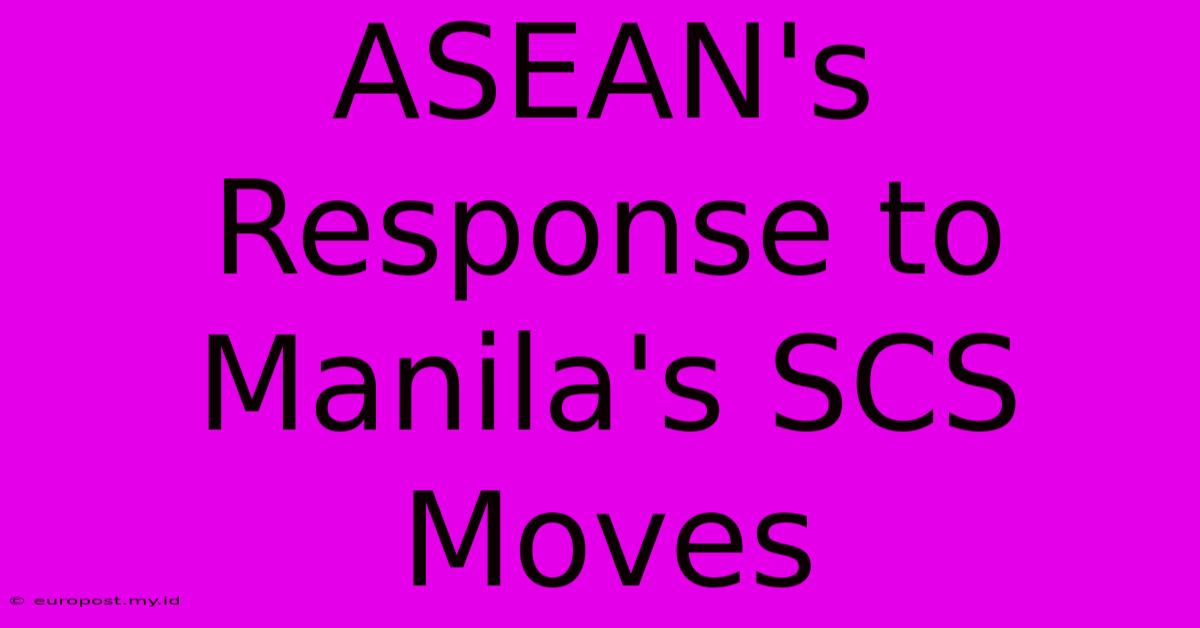ASEAN's Response To Manila's SCS Moves

Discover more in-depth information on our site. Click the link below to dive deeper: Visit the Best Website meltwatermedia.ca. Make sure you don’t miss it!
Table of Contents
ASEAN's Response to Manila's South China Sea Moves: A Balancing Act
The South China Sea (SCS) remains a region of intense geopolitical tension, with competing claims and overlapping maritime interests. Recent moves by the Philippines, a member of the Association of Southeast Asian Nations (ASEAN), have once again brought the issue to the forefront, prompting a complex and nuanced response from the regional bloc. This article will analyze ASEAN's response to Manila's actions in the SCS, highlighting the challenges and the delicate balancing act the organization faces.
Understanding Manila's Actions
The Philippines, under President Ferdinand Marcos Jr., has adopted a more assertive stance towards China's claims in the SCS. This includes:
- Increased military cooperation with allies: The Philippines has strengthened its defense ties with the US, Japan, and Australia, facilitating joint military exercises and enhancing its capacity to defend its sovereign territory. This is a direct response to perceived Chinese aggression.
- Strengthened diplomatic efforts: Manila has actively pursued diplomatic channels to address its concerns, leveraging international law and the 2016 arbitral ruling which invalidated China's expansive nine-dash line claim. This strategy aims to garner international support and pressure China to comply with international norms.
- Enhanced maritime patrols: The Philippines has stepped up maritime patrols in its exclusive economic zone (EEZ) to deter Chinese incursions and protect its fishing rights. This demonstrates a commitment to safeguarding its sovereign rights despite the risks of confrontation.
These actions reflect a shift away from a previous policy of appeasement and towards a more proactive approach to defending the Philippines' interests in the SCS.
ASEAN's Cautious Response
ASEAN's response to Manila's actions has been characterized by caution and a delicate balance between maintaining regional stability and upholding the principles of international law. The organization faces several significant challenges:
- Maintaining unity: ASEAN comprises diverse members with varying relationships with China. Some members prioritize economic ties with China, while others share the Philippines' concerns about Chinese assertiveness. This internal division makes it difficult to present a unified front.
- Avoiding escalation: ASEAN seeks to prevent any escalation of tensions that could lead to armed conflict. Its approach prioritizes diplomatic solutions and de-escalation efforts, even if it means compromising on certain principles.
- Balancing competing interests: ASEAN must balance its commitment to upholding international law and the UN Convention on the Law of the Sea (UNCLOS) with its desire to maintain good relations with China, a major economic partner. This requires careful diplomacy and strategic maneuvering.
ASEAN's Strategies
ASEAN's response has involved several key strategies:
- Emphasis on dialogue and diplomacy: ASEAN consistently calls for dialogue and peaceful resolution of disputes through existing mechanisms, such as the Code of Conduct in the South China Sea (COC). However, progress on the COC remains slow.
- Promoting regional cooperation: ASEAN continues to emphasize regional cooperation on issues such as maritime security, fisheries management, and environmental protection, even amidst the ongoing disputes. This approach aims to create a more conducive environment for resolving conflicts.
- Supporting international law: While not explicitly criticizing China, ASEAN statements generally reaffirm the importance of UNCLOS and the 2016 arbitral ruling, implicitly supporting the Philippines' position.
The Challenges Ahead
The future of ASEAN's response to Manila's SCS moves hinges on several factors:
- The pace of COC negotiations: A comprehensive and effectively enforced COC could significantly reduce tensions and provide a framework for managing disputes. However, achieving consensus on the COC remains a major challenge.
- China's response: China's response to Manila's assertiveness will significantly shape the regional dynamic. Escalatory actions from China could undermine ASEAN's efforts at de-escalation.
- The role of external powers: The involvement of external powers, such as the US, Japan, and Australia, can both assist and complicate ASEAN's efforts. While their support can strengthen the Philippines' position, it could also lead to increased tensions with China.
Conclusion:
ASEAN's response to Manila's actions in the SCS reflects a complex balancing act. The organization faces the challenging task of maintaining regional stability while upholding international law and supporting its member states' legitimate interests. The effectiveness of ASEAN's response will depend on its ability to navigate the competing interests of its members, secure progress on the COC, and manage the responses of regional and extra-regional powers. The South China Sea remains a volatile area, and ASEAN's role in managing the tensions will continue to be crucial in the years to come.

Thank you for taking the time to explore our website ASEAN's Response To Manila's SCS Moves. We hope you find the information useful. Feel free to contact us for any questions, and don’t forget to bookmark us for future visits!
We truly appreciate your visit to explore more about ASEAN's Response To Manila's SCS Moves. Let us know if you need further assistance. Be sure to bookmark this site and visit us again soon!
Featured Posts
-
Philippines A Maritime Powerhouse
Nov 16, 2024
-
Future Of Business Intelligence
Nov 16, 2024
-
Watch Scotland Vs Croatia Game Free
Nov 16, 2024
-
Tilak Varmas Motivation Two T20 Centuries
Nov 16, 2024
-
Producers Actions Nayantharas Complaint
Nov 16, 2024
